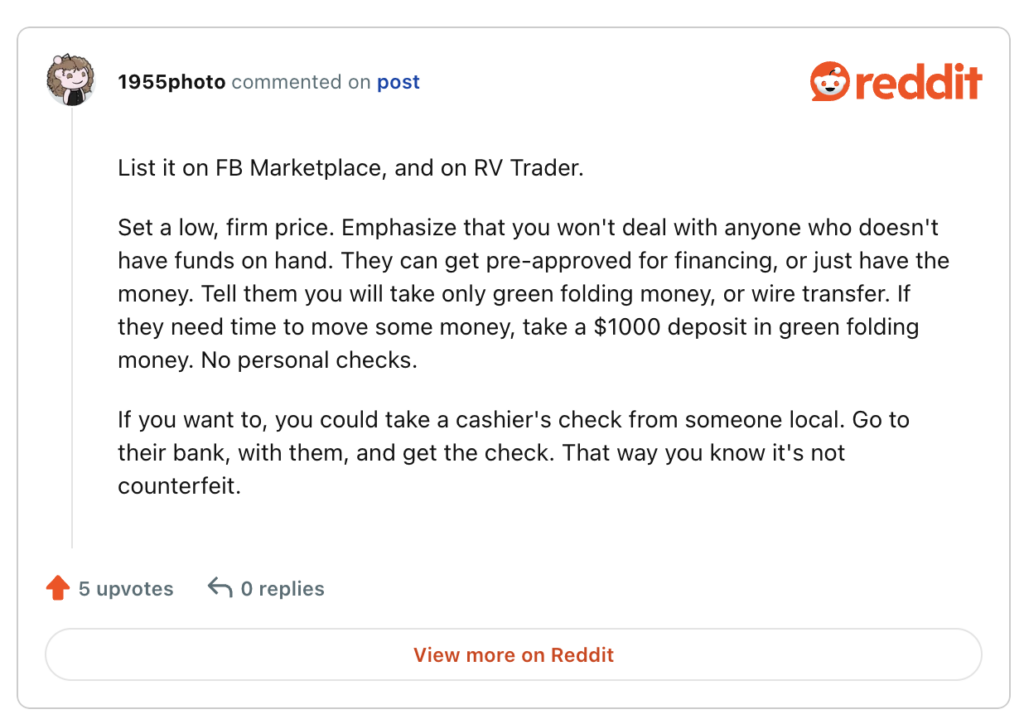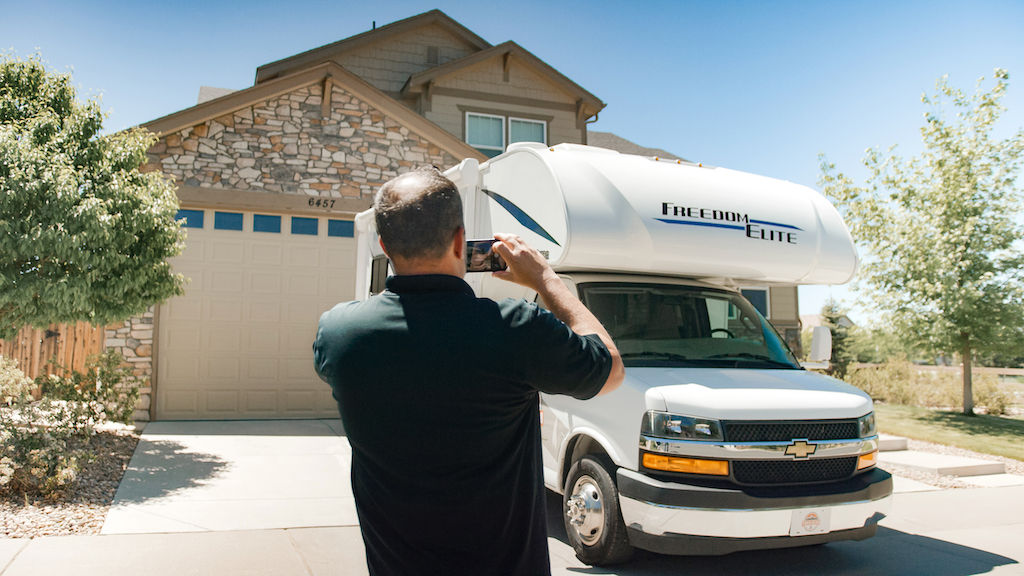
Whether you’re buying or selling an RV, you’ll want to know the NADA RV values and Kelley Blue Book Used RV values for similar models to help you make an informed decision.
NADA RV values are similar to Kelley Blue Book RV values, and are determined by a number of factors. These include the make and model of the RV, the age, the mileage, and even the time of year you decide to buy or sell. Let’s take a look at how NADA RV values are determined and how you can use that information to sell, trade, or buy a new or used RV in 2025.
RVshare pro tip: Try renting out your RV before selling it. You can test out how you feel about giving up your RV while earning income at the same time.
Table of Contents
- Kelley Blue Book for RVs
- What your RV is worth
- How to find NADA used RV values
- How much does an RV depreciate?
- How do I sell my used RV?
- Maximize your RV value
- NADA RV Values Glossary of Terms
- Earn money listing your RV
A Kelley Blue Book for RVs, Campers, and Trailers
If you have experience finding the value of vehicles, you’re probably used to getting Kelley Blue Book values. However, Kelley Blue Book doesn’t actually offer RV valuations. Other options include NADA, RV Trader, and calculating based on what you find on sites such as Craigslist and National Vehicle.
National Automobile Dealers’ Association (NADA)
NADA, or the National Automobile Dealers’ Association, provides values for used RVs. They list prices and values for motorhomes, travel trailers, and even truck campers and park models.
RV Trader
Platforms like RV Trader, which help people buy and sell RVs, are also a great resource for getting an approximate value of your rig. Check out their price checker tool as a great starting point.
DIY RV Value
You can also search other buying and selling websites like Craigslist, National Vehicle, or local RV dealerships.
What Your RV Is Worth
When it comes to determining an RV’s or camper’s value, there are a lot of variables that go into the baseline figure. Here are a few factors to keep in mind:
- The make, model, and year of the vehicle. Certain brand names, like Airstream, are known to hold their value better.
- Newer, higher-rated models will generally command a higher price than older, lower-rated ones.
- Vehicle size – larger RVs are typically valued higher than smaller ones.
- The mileage – low mileage is preferable to high mileage.
- The condition of the engine, transmission, and other parts crucial to driving an RV.
- The configuration and overall condition of the RV’s interior.
- The number and types of extras that are included with the vehicle.
But the real answer to the question, “How much is my RV worth?” is… whatever somebody’s willing to pay for it. Even if you find a baseline figure for the estimated value, it might be difficult (or easy) to sell based on factors like supply and demand for RVs when you’re trying to sell.
Consider investing in a certified RV appraisal for enhanced leverage when selling. These appraisals include exclusive NADA and RVDA data not accessible to the public, providing a suggested price range that strengthens your negotiation position. Appraisal costs typically start around $100 in most states.
What determines what my RV will sell for?

How to Find NADA RV Values
If you do want to find out your RV’s “blue book” value, you can use the NADA website. Fortunately, it’s pretty straightforward and user-friendly.
- Navigate to NADA’s RV value homepage: choose the “type” of RV you have (or are looking at buying). You can choose from travel trailers, motorhomes, camping trailers like smaller pop-up trailers, truck-top campers, or park models. NADA also provides valuations for tow vehicles.
- Click on the “motorhome” category: you’ll be directed to a page that will allow you to choose from NADA’s listed motorhome manufacturers. Save time by looking through the most popular RVs, or you can choose from the more extended and comprehensive list in the drop-down menu.
- Filter by year and style: you’ll see a list with various models from that make, which you can filter by year and style. You’ll also have the option to hide or show specs such as length, design, floor plan, and slides.
- Provide your zip code: once you click on the RV model that matches yours, you’ll be asked to provide your zip code. As with Kelley Blue Book, RV trade-in values vary based on where in the country you are.
- Choose your features: from here, you’ll see a list of optional features that you can add or take away from your rig. These include HVAC units, upgraded appliances, leveling systems, and other options that could raise the value. You can also opt to skip this step and just see the baseline value.
- Review your results: once you’ve narrowed it down, NADA will display your RV with the suggested, average, and low retail prices. You can use this information to help better prepare yourself for setting a price or for vetting potential RVs you’re interested in.
How Much Does an RV Depreciate?
Like other vehicles, RVs don’t appreciate in value.
New RV values take a pretty big hit the moment they’re driven off the lot. The depreciation continues for the life of the RV. If you’re buying a used RV, this means that you can expect to pay less than you would for a new one. But if you’re selling, it’s important to realize that you won’t get anything close to what you paid for your RV when it was new. RV resale values are typically on the low side. Sprucing up the interior and making sure the mechanics are in good working order will improve the value. But ultimately, you need to be realistic about the value of used RVs.
The extent to which travel trailers, campers, and RVs depreciate varies based on how many miles the RV has been driven, the condition of its systems and interior, and the type of rig. Certain RVs like Prevosts and Airstreams tend to maintain their value well over time. However, an entry-level Coachman may depreciate more quickly.
There are two ways to discuss the worth of your RV going down.
- Diminished value, or loss of value: The diminished value is the difference between your RV’s market value before something like an accident or other damage, and it’s value once it has been repaired after an accident or damage.
- Depreciation: Depreciation is the RV’s loss of its value over time, caused by normal wear and tear on the vehicle. Things like your RV’s mileage and age cause depreciation of the vehicle.
Loss of value happens suddenly and is unpredictable. Depreciation happens gradually over time, and can be calculated and accounted for each year.
What does RV depreciation look like over time?
While there’s not a go-to RV depreciation calculator available, some experts suggest that an RV loses about 20% of its value after the first year, a figure that slows significantly after that. By the end of the second year, it may only have lost about 23% total, 28% by Year Three, and 35% by Year Four.
There’s no one easy way to figure out how much your RV will depreciate in a given amount of time. The best course of action is to use the steps above to find an approximation of your RV’s value.
| Year | Depreciation (%) |
|---|---|
| Year 1 | 20% |
| Year 2 | Additional 3% |
| Year 3 | Additional 5% |
| Year 4 | Additional 7% |
This chart demonstrates how the depreciation of an RV slows down over time, with the highest percentage lost typically occurring in the first year and gradually decreasing in subsequent years.
Campers vs. RVs: Does Value Change Based on Toppers, Towables, and Driveables?
Yes, the value of campers and RVs can vary significantly depending on whether they’re toppers, towables, or drivables. The value is shaped by factors like use case, convenience, and resale potential.
- Toppers (like truck campers) tend to be the most affordable and versatile option. They’re lightweight, detachable, and great for weekend trips or off-grid adventures. However, their resale value depends heavily on the condition of the camper.
- Towables (travel trailers, fifth wheels, teardrops) come in a wide range of prices and features, from budget-friendly basics to luxury models. Their value can depend on tow vehicle compatibility and whether they offer features like slide-outs, bathrooms, or off-road capability. Since you’re not putting miles on the camper itself, towables tend to hold value better over time.
- Driveables (Motorhomes, Class A, B, and C RVs) are generally the most expensive upfront, but they combine transportation and living space. Their value is impacted by mileage, maintenance, and engine condition. While they offer unmatched convenience, especially for long trips, they can depreciate faster than towables because of wear and tear on the drivetrain.
How do I sell my used RV?
Once you see your RV’s retail or trade-in value, you may still wonder how to sell it. Just as with selling a vehicle, you have a couple of different options: you can sell your RV on the private market, trade it in at a dealership, or sell it on consignment.
There are pluses and minuses to all of these approaches. A dealership might not net you as much money as a private sale, but it’s usually an easier and quicker process. Keep in mind that you’ll have to find a dealer who’s willing to sell your make and model; some are interested only in their home brand.
A private sale could take longer, especially if there aren’t many buyers in your area, or buyers aren’t looking for your make and model.
If you’re making a private sale, always make sure you ask the buyer for cash, cashier’s check, or money order. Accepting checks is dangerous when that much money is at stake.
You’ll also want to go through all the required paperwork to ensure the state knows the RV is no longer yours and you’re no longer liable for it. Generally, you need to file a bill of sale and title transfer with the DMV. 1955photo from Reddit recommends Facebook Marketplace or RV Trader:

Comment
byu/Dramatic_Story9414 from discussion
inRVLiving
Maximize your RV Value
RV Values Change With the Seasons
Unlike cars, RV values are often dependent on what time of year you’re looking to buy or sell. Summer is typically RV season, so values tend to be higher in the spring when potential buyers have camping vacations on their minds. If you go to sell your RV in the fall when the camping season has slowed, you may find that your RV resale value takes a dip.
The exception to this, however, is snowbirds. These retirees are looking to buy an RV to drive south to live in it for the winter. You may find that late summer or early fall is an ideal time to sell your RV to these buyers. You’ll want to target your for-sale ads to the specific audience you want to reach, depending on what time of year you decide to sell.
Clean Up Trouble Spots
To keep your RV value high, you’ll want to eliminate signs of major damage or disrepair before selling. Try to look at it from the perspective of a potential buyer. Aesthetics are important, especially since certain things can signal bigger problems. Water stains don’t look good, but more importantly, they can indicate a leak or hidden mold.
Good Condition Goes a Long Way
An RV is meant to be lived in, but if yours looks worn it will take a hit in value. Beat up and outdated upholstery, noticeable cosmetic issues, old appliances that show their age, and obvious wear and tear can lower your RV resale value. Dents and dings on the exterior will also bring down RV value. You’ll want to fix up any interior or exterior damage and make sure appliances are in good working order. Otherwise, you can expect potential buyers to use these issues as bargaining chips to get you to come down on price.
Stage Well to Improve Perceived Value
Think of selling your RV as comparable to selling your home. You don’t just want to make it look presentable — you want to make it look great! Clear out the clutter, clean up everything, and make it look ready to live in immediately. If a buyer thinks he or she doesn’t have to do anything to use the RV except hand over money, you’ll probably improve your RV value, and you might be able to ask for more money.

NADA RV Values Glossary of Terms
- Suggested List Price (MSRP): The sticker price or manufacturer’s suggested retail price (MSRP) for new RVs at dealerships. It serves as a starting point for negotiations, though actual purchase prices often differ based on market conditions.
- Low Retail Price (Dealer Trade): The price typically paid at dealerships for used RVs in below-average condition or with high mileage. It also represents the maximum amount most dealers will offer for a trade-in.
- Average Retail Price (Retail Value): The price expected when purchasing a used RV from a dealership, serving as a baseline for negotiations within a specific geographic area. Prices can vary among dealers based on RV condition and valuation methods.
- Private Party Value: A term used by Kelley Blue Book to denote the initial value private sellers can use as a starting point for negotiating the price of a used vehicle. Not directly used by NADA Guide.
- Wholesale Value: The amount dealers receive when selling an RV at an auction or the cash offered if the dealer buys the RV outright. NADA Guide’s wholesale pricing is not publicly accessible, but a rough estimate can be derived by subtracting 10% to 20% from the low retail price.
- Depreciation: The reduction in RV value over time, similar to cars and trucks. RVs typically depreciate by 10% to 20% in the first year and continue to lose value, with an average depreciation of 36% to 38% after five years. Factors influencing NADA Guides value calculation also affect depreciation rates.
- Blue Book Value: “Book value” or “Blue Book value” is a generic term used to determine the actual worth of RVs and passenger vehicles. Initially coined by Kelley Blue Book, it has become widely adopted as the standard term for automotive appraisals.
Want to earn money on your RV without selling it?
If you’re thinking about putting your RV on the market because of the expense, there might be a better option.
Listing your RV on RVshare is a great way to put your rig to work for you when it would otherwise be sitting empty.
Using our peer-to-peer RV rental marketplace platform is simple. Create a high-quality listing complete with details and pictures of your rig. Customize your preferences and options, and RVshare will take care of the marketing. You’re in control of who rents your RV and how long they rent it for, and our rating and verification systems add an extra layer of security.
All qualified RV rentals are covered by A-rated insurance policies for the duration of the rental period. And if you have questions or concerns, our team will be standing by to help you get started; we even offer one-on-one RV rental coaching!






